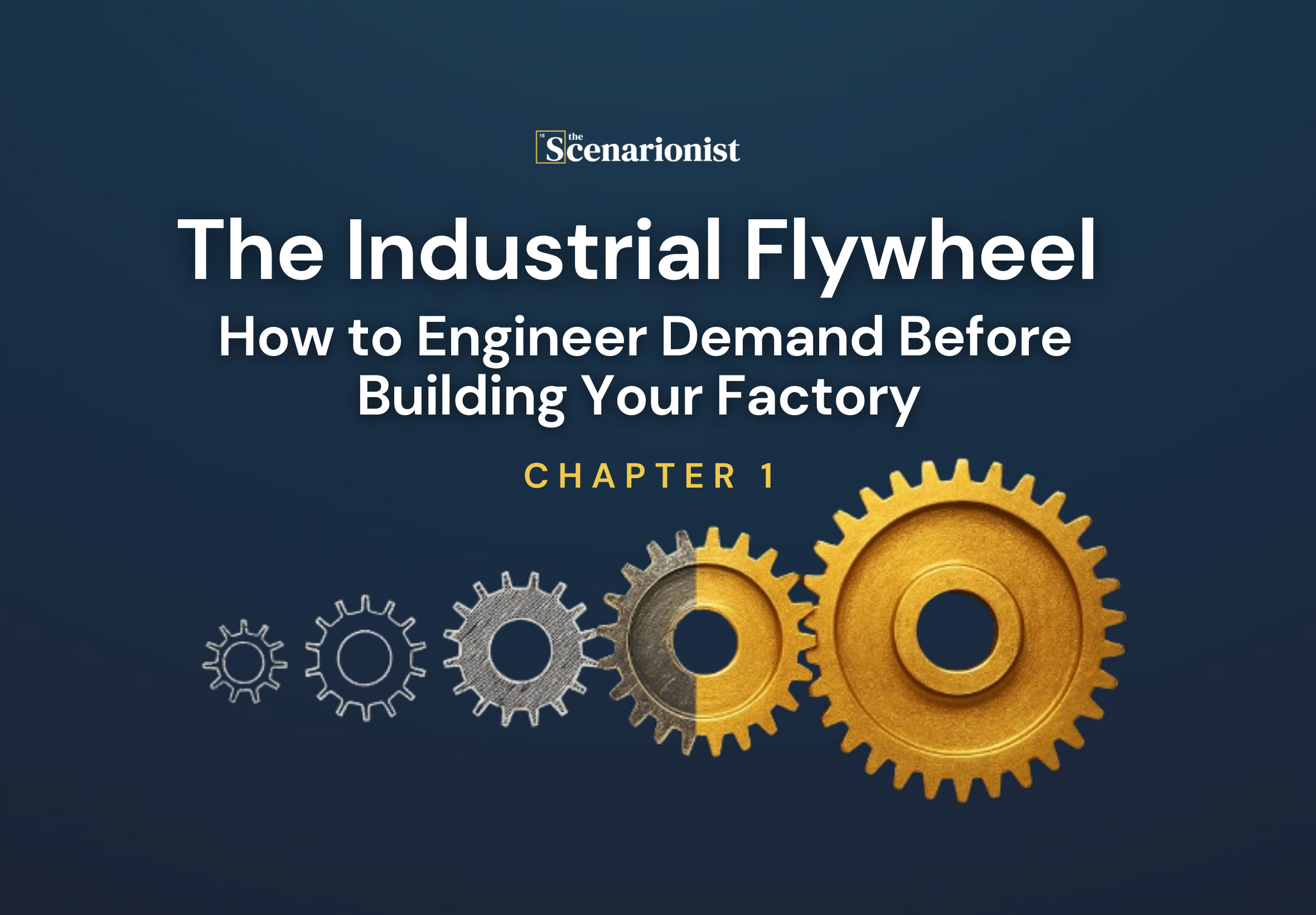The Industrial Flywheel: How to Engineer Demand Before Building Your Factory | Chapter 1/2
What if your factory could sell before it exists?
One of the biggest misconceptions in deep tech is that commercial conversations should begin after the prototype is proven. In reality, the opposite is often true: early engagement sharpens your technology. It clarifies where the value lies, what constraints matter most to buyers, and which performance metrics are actually meaningful in an applied context.
More importantly, early demand creates alignment. When investors, regulators, and pilot partners all begin to see the same signals—real market interest, credible adoption pathways, well-defined use cases—the road to scale becomes not only clearer, but less risky.
You’re not just building something impressive. You’re building something wanted.
There’s a scene that plays out quietly—but crucially—across the corridors of industrial innovation.
A young startup has perfected a new material, or a cutting-edge robotics line, or perhaps a breakthrough in biotechnology. The lab tests shine. Investors are intrigued. The vision is clear.
And yet, a question lingers—often too late: who exactly is ready to buy this, and when?
Unlike software, where a few lines of code can launch an MVP, the world of deep tech requires factories, supply chains, and certifications—substantial investments well before the market has truly responded.
This is the first chapter in a two-part series for those building or backing physical, industrial, or scientific technologies—and who want to bake in market traction from the start.
In this first part, we focus on a foundational challenge: how do you engineer demand before you build capacity?
Not through hype or premature commercialization, but by generating meaningful early signals—relationships, partnerships, and structured commitments—that shape your roadmap and reduce downstream risk.
We’ll address strategic questions such as:
What are the core pillars of demand engineering in industrial innovation?
How do you convert early interest into tangible signals?
What frameworks help align technical development with real commercial pull?
How can regulation act not as a barrier, but as a catalyst for demand?
And what kind of team structure best supports a demand-led growth strategy in deep tech?
Why This Matters—Even at the Earliest Stages
If you’re working on something truly new—a next-gen composite, a bioengineered material, a quantum sensor—your instinct may be to stay heads-down until the technology is fully proven. The science comes first. The product second. Then the market.
But in industrial innovation, waiting too long to engage potential buyers can create silent risks.
Markets aren’t passive.
They’re shaped by timelines, procurement cycles, technical standards, and shifting regulatory environments.
And by the time your product is ready, your window might be narrower than you expected.
That doesn’t mean rushing to sell something half-baked.
It means inviting the right stakeholders into the development process early enough that their needs shape your decisions.
It’s the difference between building something for the market, and building it with the market.
Demand in deep tech doesn’t start with a product launch.
It starts with a conversation—with a partner, a future buyer, or a technical champion who sees what you’re building and says, “If you can make this work, we want in.”
✨ This Insight is reserved for Premium Members.
By joining The Scenarionist Premium, you’ll unlock full access to this Insight, along with our in-depth Venture Guide Series—a collection of strategic frameworks and case-based insights designed to help you build and back exceptional deep tech companies, and The Deep Tech Negotiation Playbook Series, where we unpack the tactics, levers, and deal dynamics that define successful founder–investor negotiations in complex, science-driven ventures.
The Industrial Flywheel: How to Engineer Demand Before You Build Your Factory | Chapter 1.
In the software world, you spin up an MVP, put it in front of users, iterate in quick sprints, and dial up server capacity as traffic grows. It’s all seamless and agile. In deep tech, though, you’re dealing with a different kind of creature. Factories come with colossal price tags and real-estate footprints.
Once you pour capital into constructing an industrial facility—say, advanced robotics lines, microfabrication foundries, specialized chemical or materials processing plants, or biotech labs—you’re suddenly staring down:
High fixed costs: real estate, specialized equipment, supply chain overhead.
Long lead times: building a factory could take anywhere from 6 to 24 months, plus extra time for regulatory and environmental approvals.
Complex risk: your technology might not scale linearly from bench to industrial volumes; pilot data may skip over real-world production quirks.
In software, “move fast and break things” can pan out just fine. If you break the code, you roll back and push a new build. In deep tech, breaking things might set you back hundreds of thousands of euros in advanced materials or specialized experiments. That’s why your iteration cycles run slower—though the principle of early validation is just as crucial.
Deep tech and SaaS might seem like night and day. Software scales on tiny incremental costs; hardware demands a massive upfront commitment. Yet over the last decade, SaaS founders have unleashed a bag of “growth hacks” and operational frameworks geared toward derisking product–market fit and rallying those early demand signals. We can draw inspiration from these strategies—while acknowledging hardware or industrial solutions can’t simply carbon-copy every SaaS go-to-market trick.
One major takeaway from SaaS is continuous engagement with potential users. In deep tech, that can mean staying in tight communication with pilot partners and prospective buyers long before the cement starts pouring on your factory floor.
So how do we systematically engineer that demand?
What if your factory could sell before it exists?
This Insight explores a new approach for modern industrial pioneers—those who don’t just build machines, but engineer momentum. It’s about creating market gravity early, validating real demand, and launching with leverage.
Because before the factory rises, the flywheel has to spin.





